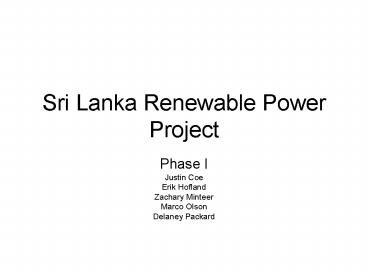Sri Lanka Renewable Power Project
1 / 20
Title:
Sri Lanka Renewable Power Project
Description:
Sri Lanka Renewable Power Project. Phase I. Justin Coe. Erik Hofland. Zachary Minteer ... Phase I of this Capstone project is a general method of renewable ... –
Number of Views:23
Avg rating:3.0/5.0
Title: Sri Lanka Renewable Power Project
1
Sri Lanka Renewable Power Project
- Phase I
- Justin Coe
- Erik Hofland
- Zachary Minteer
- Marco Olson
- Delaney Packard
2
Phase I Description
- Phase I of this Capstone project is a general
method of renewable power system design and
optimization that can be applied to any specific
set of resource and load distributions. - This method consists of two parts
- Expected Monetary Value (EMV) optimization
- System Resource Distribution (SRD) analysis
3
EMV - Theory
- Description
- Determines optimal sizes of power sources based
on load and resource profile averages - Program minimizes the EMV by choosing the
configuration which uses the least amount of
diesel
4
EMV Decision Tree
5
EMV Configuration Output
- For each generation configuration (Q), the
average output is calculated by the sum of the
products of the probability arrays (Pi) and the
resource availability arrays (Xi). - Value ?(PiXiQ), for all i.
- Value is calculated for wind, solar and
batteries. - EMV (Load - ?Values)Cost of Diesel
6
EMV Resource
- Example resource profile array
- Pwind .3, .2, .2, .1, .2
- Xwind 1, .75, .5, .25, 0
- This profile indicates for 30 of the time, the
turbine operates at full power, 20 of the time
at 75 power, 20 of the time at 50 power, 10
of the time at 25 of the power, and 20 of the
time at 0 power. - The wind and solar resource profile arrays are
compiled from specific site data.
7
EMV - Battery Probability
- The probability of the batteries being charged
(Pb) is approximated by considering the size of
the wind and solar installations, the size of the
load, and the size of the batteries as shown
below - The probability is between 0 and 1.
8
EMV - Calculation
- The EMV of each configuration calculates the cost
of diesel required to power the amount of load
not supplied by available renewable sources and
batteries. - The EMV is calculated for every possible source
configuration the optimal configuration has an
EMV which is closest to 0.
9
EMV - Interpretation
- The smallest EMV represents the least expensive
operating solution. The long term cost of the
power system can be determined by multiplying the
EMV (given in cost per hour of operation) by the
number of hours in a given period. Total system
cost is this operating cost plus the installation
costs. The best power system configuration is the
one which minimizes the total system cost.
10
EMV Approximations and Assumptions
- Maintenance costs are ignored.
- Load is an average for a given hour.
- Resource profiles are average values.
- Battery probability is approximated.
11
EMV - Example
- Load72.5 kW
- Pwind0.25,0.25,0.5
- Xwind1,.50, 0
- Qwind 20 30 40 50 60 70 80 90 100
- Psolar0.4,0.1,0.5
- Xsolar1,0.5,0
- Qsolar 20 30 40 50 60 70 80 90 100
- Qbattery 3 6 9 12 15 18 21 24 27
12
EMV - Example
13
SRD
- Hourly analysis of system performance
- Load and resource profiles can be arbitrarily
defined to represent different scenarios - Useful to account for location specific anomalies
- Verification of EMV solution
- Based on Linear Programming Upper Bound (LPUB)
optimization method
14
SRD - Optimization
- Minimize
- Ctotal CwXw CsXs Cb Xb CdXd
- Subject to
- Xw Xs Xb Xd gt Demand
- Xi lt Xi,max
15
SRD - Example
16
SRD - Example
17
SRD No Wind Example
18
SRD No Wind Example, Day 2
19
SRD No Wind Example
- Day 1 Diesel Usage 759 kWh each day
- Day 2 Diesel Usage 1150 kWh
- Total Diesel Used 1909 kWh
- About 150 gallons of Diesel
- Amount of diesel storage is site specific
20
Phase I Conclusion
- EMV analysis provides a starting point for
determining optimal power system sizing - SRD analysis can provide insight into how well
the system performs in specific situations - An iterative approach to the SRD analysis should
be used for final sizing decisions






![[Project Name] Post-Mortem](https://s3.amazonaws.com/images.powershow.com/P1249003583YeXzc.th0.jpg?_=201411050411)
























